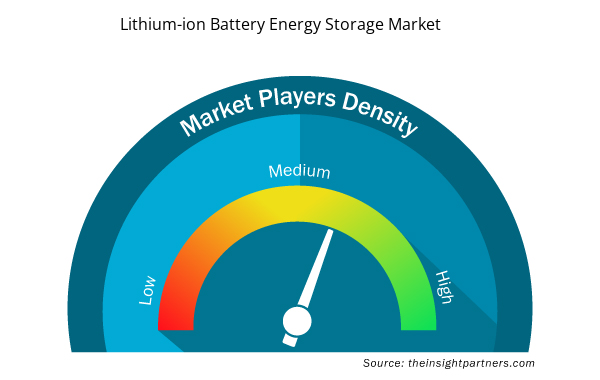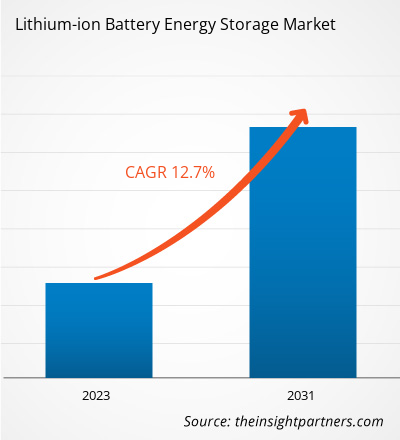锂离子电池储能市场规模预计将从 2023 年的 141.2 亿美元增至 2031 年的 367 亿美元。预计 2023-2031 年期间该市场的复合年增长率将达到12.7%。预计虚拟发电厂需求的增长仍将是锂离子电池储能市场的一个主要趋势。
锂离子电池储能市场分析
预计全球对可再生能源发电的需求不断增长将在预测期内推动市场增长。此外,亚太地区、欧洲和北美等地区太阳能和风力发电厂的不断建立预计将推动对锂离子电池储能的需求,从而推动 2023 年至 2031 年的市场增长。此外,全球电动汽车 ( EV ) 行业的增长预计将减少运输行业的碳排放,从而推动对可再生能源发电和电池储能解决方案的需求,从而推动分析时间范围内的市场增长。
锂离子电池储能市场概况
锂离子电池储能市场的关键利益相关者包括原材料供应商、零部件制造商、锂离子电池储能制造商和最终用户。原材料供应商是锂离子电池储能市场生态系统中的关键利益相关者。仅澳大利亚就生产了全球 52% 的锂。根据电极材料,锂电池有六种不同类型:LFP、NMC、LCO、NCA、LTO和LMO。锂离子电池最主要使用的原材料是阴极材料、阳极材料、电解质、隔膜和集电器。根据电池形状,锂离子电池有三种类型:圆柱形、软包形和方形,每种都有不同的电池性能参数。锂离子电池储能系统所需的原材料包括锂、钴、镍、锰、石墨、铜和铝等有色金属和矿物。主要的锂离子电池制造商包括 A123 Systems LLC、松下公司、三星 SDI 公司、东芝公司等。
定制此报告以满足您的需求
您可以免费定制任何报告,包括本报告的部分内容、国家级分析、Excel 数据包,以及为初创企业和大学提供优惠和折扣
- 获取此报告的关键市场趋势。这个免费样品将包括数据分析,从市场趋势到估计和预测。
锂离子电池储能市场驱动因素和机遇
太阳能和风能项目增多,市场青睐
全球范围内,为促进可再生能源发电而建立的太阳能和风能项目的增加预计将在未来几年推动市场增长。产能的增加得益于众多政府举措和支持,包括拍卖、上网电价、净计量和差价合约。从 2021 年到 2022 年,各经济体政府制定了重大政策和目标调整,影响了太阳能光伏的增长。例如,2021 年 7 月,欧盟委员会提议到 2030 年将联盟的可再生能源目标从 32% 提高到 40%。REPowerEU计划进一步提高了目标,在 2022 年 5 月将其提高到 45%(这将需要 1,236 GW的可再生能源安装量,其中包括 600 GW的太阳能光伏)。美国联邦政府于 2022 年 8 月出台了《通胀削减法案》,该法案将通过税收抵免和其他措施在未来十年增加对可再生能源的支持。政府的此类举措旨在建立太阳能和风能项目,预计将在未来几年推动市场增长。
未来的可再生能源项目
结合可再生能源的电池存储系统 (BESS) 具有诸多优势,例如能源自给自足、成本效益、能源弹性、环境效益和电网支持。这就是许多工业化国家依赖可再生能源的原因。根据国际能源署 (IEA) 的数据,预计中国将在 2022 年至 2027 年期间增加全球约一半的新增可再生能源发电量,因为尽管取消了对太阳能和风能的补贴,但预计未来五年 BESS 的增长仍将加速。BESS 可以通过向电网注入无功功率来维持稳定的电压范围。该系统对可再生能源非常重要,因为可再生能源的间歇性会导致电压波动。它可以提供黑启动功能,使电力系统在完全断电后重新启动。
锂离子电池储能市场报告细分分析
锂离子电池储能市场分析的关键部分包括容量、连接类型和最终用户
- 根据容量,锂离子电池储能 (LiBES) 市场分为 0-10 kW、10-20 kW、20-50 kW 和 50 kW 以上。10-20 kW 部分在 2023 年占据了更大的市场份额。
- 根据连接类型,市场分为并网和离网。2023 年,并网部分占据了较大的市场份额。
- 就最终用途而言,市场分为住宅、商业、工业和公用事业。公用事业部门在 2023 年占据了相当大的市场份额。
锂离子电池储能市场份额(按地区)分析
锂离子电池储能市场报告的地理范围主要分为五个区域:北美、亚太、欧洲、中东和非洲、南美和中美。
到 2023 年,亚太地区将以超过 43% 的份额领先市场。中国是亚太地区锂离子电池储能市场的主要国家之一。根据中国国家能源局 (NEA) 的数据,太阳能和风能产量增长了 21%,到 2022 年达到 1,190 TWh。这占中国总电力消耗的 13.8%,大致相当于所有城乡家庭的用电量。此外,政府的支持性政策将进一步扩大可再生能源的安装容量。根据中华人民共和国国务院的规定,中国在 2022 年增加了 125 吉瓦的太阳能和风电场总容量,使总容量达到 1,213 吉瓦,其中光伏发电占 87.4 吉瓦。这些开发太阳能和风能项目的举措预计将推动锂离子电池储能市场从 2023 年到 2031 年的发展。
锂离子电池储能市场区域洞察
Insight Partners 的分析师已详尽解释了预测期内影响锂离子电池储能市场的区域趋势和因素。本节还讨论了北美、欧洲、亚太地区、中东和非洲以及南美和中美洲的锂离子电池储能市场细分和地理位置。

- 获取锂离子电池储能市场的区域特定数据
锂离子电池储能市场报告范围
| 报告属性 | 细节 |
|---|---|
| 2023 年的市场规模 | 141.2亿美元 |
| 2031 年市场规模 | 367亿美元 |
| 全球复合年增长率(2023 - 2031) | 12.7% |
| 史料 | 2021-2022 |
| 预测期 | 2023-2031 |
| 涵盖的领域 | 按容量
|
| 覆盖地区和国家 | 北美
|
| 市场领导者和主要公司简介 |
|
市场参与者密度:了解其对商业动态的影响
锂离子电池储能市场正在快速增长,这得益于终端用户需求的不断增长,而这些需求又源于消费者偏好的不断变化、技术进步以及对产品优势的认识不断提高等因素。随着需求的增加,企业正在扩大其产品范围,进行创新以满足消费者的需求,并利用新兴趋势,从而进一步推动市场增长。
市场参与者密度是指在特定市场或行业内运营的企业或公司的分布情况。它表明在给定市场空间中,相对于其规模或总市场价值,有多少竞争对手(市场参与者)存在。
在锂离子电池储能市场运营的主要公司有:
- NextEra能源公司
- 公司
- 科雷电力
- 意大利国家电力公司绿色能源
- 蜻蜓能源
- 西门子能源
免责声明:上面列出的公司没有按照任何特定顺序排列。

- 了解锂离子电池储能市场顶级关键参与者概况
锂离子电池储能市场新闻和最新发展
通过收集一手和二手研究的定性和定量数据来评估锂离子电池储能市场,其中包括重要的公司出版物、协会数据和数据库。以下列出了锂离子电池储能市场的一些发展情况:
- Morrow Batteries 和 ABB 签署了两份谅解备忘录,以加强双方的合作伙伴关系,推动社会各界向可再生能源和电气化的转变。根据协议,ABB 已被选为 Morrow 制造和电力供应的非独家首选技术供应商。目标是确保计划在挪威 Eyde 能源园区建造的超级工厂成为全球最具成本效益和可持续性的设施之一。此次合作旨在利用 ABB 的专业知识和经验来优化 Morrow 的制造流程,并实现高质量、可持续电池的生产。(来源:ABB Ltd,新闻稿,2022 年 9 月)
- Exide Industries 及其合资伙伴 Leclanche SA 宣布在古吉拉特邦启动印度最大的锂离子电池工厂。该工厂拥有六条自动化装配线,装机容量为 1.5 GWh。它将专注于生产汽车和储能应用的电池。合资公司 Nexcharge 发布声明,确认该工厂开始大规模生产。(来源:Exide Industries Ltd,新闻稿,2022 年 5 月)
锂离子电池储能市场报告范围和交付成果
“锂离子电池储能市场规模和预测(2021-2031)”报告对以下领域进行了详细的市场分析:
- 锂离子电池储能市场规模及全球、区域和国家层面所有主要细分市场的预测
- 锂离子电池储能市场趋势以及驱动因素、限制因素和关键机遇等市场动态
- 详细的 PEST 和 SWOT 分析
- 锂离子电池储能市场分析,涵盖主要市场趋势、全球和区域框架、主要参与者、法规和最新市场发展
- 行业格局和竞争分析,涵盖市场集中度、热图分析、知名参与者以及锂离子电池储能市场的最新发展
- 详细的公司简介
- 历史分析(2 年)、基准年、预测(7 年)及复合年增长率
- PEST 和 SWOT 分析
- 市场规模价值/数量 - 全球、区域、国家
- 行业和竞争格局
- Excel 数据集



Report Coverage
Revenue forecast, Company Analysis, Industry landscape, Growth factors, and Trends

Segment Covered
This text is related
to segments covered.

Regional Scope
North America, Europe, Asia Pacific, Middle East & Africa, South & Central America

Country Scope
This text is related
to country scope.
常见问题
Asia Pacific dominated the Lithium-ion battery energy storage market in 2023.
The rise in demand for virtual power plants is the future trend of the Lithium-ion battery energy storage market.
NextEra Energy, Inc., KORE Power, Enel Green Power, Dragonfly Energy, Siemens Energy, ESS, Inc., Ameresco Solar, ACE Battery, Lithium Battery Company, and SAFT are some of the leading players in the Lithium-ion battery energy storage market.
US$ 36.7 billion estimated value of the Lithium-ion battery energy storage market by 2031.
12.7% is the expected CAGR of the Lithium-ion battery energy storage market.
Trends and growth analysis reports related to Energy and Power : READ MORE..
The Insight Partners performs research in 4 major stages: Data Collection & Secondary Research, Primary Research, Data Analysis and Data Triangulation & Final Review.
- Data Collection and Secondary Research:
As a market research and consulting firm operating from a decade, we have published and advised several client across the globe. First step for any study will start with an assessment of currently available data and insights from existing reports. Further, historical and current market information is collected from Investor Presentations, Annual Reports, SEC Filings, etc., and other information related to company’s performance and market positioning are gathered from Paid Databases (Factiva, Hoovers, and Reuters) and various other publications available in public domain.
Several associations trade associates, technical forums, institutes, societies and organization are accessed to gain technical as well as market related insights through their publications such as research papers, blogs and press releases related to the studies are referred to get cues about the market. Further, white papers, journals, magazines, and other news articles published in last 3 years are scrutinized and analyzed to understand the current market trends.
- Primary Research:
The primarily interview analysis comprise of data obtained from industry participants interview and answers to survey questions gathered by in-house primary team.
For primary research, interviews are conducted with industry experts/CEOs/Marketing Managers/VPs/Subject Matter Experts from both demand and supply side to get a 360-degree view of the market. The primary team conducts several interviews based on the complexity of the markets to understand the various market trends and dynamics which makes research more credible and precise.
A typical research interview fulfils the following functions:
- Provides first-hand information on the market size, market trends, growth trends, competitive landscape, and outlook
- Validates and strengthens in-house secondary research findings
- Develops the analysis team’s expertise and market understanding
Primary research involves email interactions and telephone interviews for each market, category, segment, and sub-segment across geographies. The participants who typically take part in such a process include, but are not limited to:
- Industry participants: VPs, business development managers, market intelligence managers and national sales managers
- Outside experts: Valuation experts, research analysts and key opinion leaders specializing in the electronics and semiconductor industry.
Below is the breakup of our primary respondents by company, designation, and region:

Once we receive the confirmation from primary research sources or primary respondents, we finalize the base year market estimation and forecast the data as per the macroeconomic and microeconomic factors assessed during data collection.
- Data Analysis:
Once data is validated through both secondary as well as primary respondents, we finalize the market estimations by hypothesis formulation and factor analysis at regional and country level.
- Macro-Economic Factor Analysis:
We analyse macroeconomic indicators such the gross domestic product (GDP), increase in the demand for goods and services across industries, technological advancement, regional economic growth, governmental policies, the influence of COVID-19, PEST analysis, and other aspects. This analysis aids in setting benchmarks for various nations/regions and approximating market splits. Additionally, the general trend of the aforementioned components aid in determining the market's development possibilities.
- Country Level Data:
Various factors that are especially aligned to the country are taken into account to determine the market size for a certain area and country, including the presence of vendors, such as headquarters and offices, the country's GDP, demand patterns, and industry growth. To comprehend the market dynamics for the nation, a number of growth variables, inhibitors, application areas, and current market trends are researched. The aforementioned elements aid in determining the country's overall market's growth potential.
- Company Profile:
The “Table of Contents” is formulated by listing and analyzing more than 25 - 30 companies operating in the market ecosystem across geographies. However, we profile only 10 companies as a standard practice in our syndicate reports. These 10 companies comprise leading, emerging, and regional players. Nonetheless, our analysis is not restricted to the 10 listed companies, we also analyze other companies present in the market to develop a holistic view and understand the prevailing trends. The “Company Profiles” section in the report covers key facts, business description, products & services, financial information, SWOT analysis, and key developments. The financial information presented is extracted from the annual reports and official documents of the publicly listed companies. Upon collecting the information for the sections of respective companies, we verify them via various primary sources and then compile the data in respective company profiles. The company level information helps us in deriving the base number as well as in forecasting the market size.
- Developing Base Number:
Aggregation of sales statistics (2020-2022) and macro-economic factor, and other secondary and primary research insights are utilized to arrive at base number and related market shares for 2022. The data gaps are identified in this step and relevant market data is analyzed, collected from paid primary interviews or databases. On finalizing the base year market size, forecasts are developed on the basis of macro-economic, industry and market growth factors and company level analysis.
- Data Triangulation and Final Review:
The market findings and base year market size calculations are validated from supply as well as demand side. Demand side validations are based on macro-economic factor analysis and benchmarks for respective regions and countries. In case of supply side validations, revenues of major companies are estimated (in case not available) based on industry benchmark, approximate number of employees, product portfolio, and primary interviews revenues are gathered. Further revenue from target product/service segment is assessed to avoid overshooting of market statistics. In case of heavy deviations between supply and demand side values, all thes steps are repeated to achieve synchronization.
We follow an iterative model, wherein we share our research findings with Subject Matter Experts (SME’s) and Key Opinion Leaders (KOLs) until consensus view of the market is not formulated – this model negates any drastic deviation in the opinions of experts. Only validated and universally acceptable research findings are quoted in our reports.
We have important check points that we use to validate our research findings – which we call – data triangulation, where we validate the information, we generate from secondary sources with primary interviews and then we re-validate with our internal data bases and Subject matter experts. This comprehensive model enables us to deliver high quality, reliable data in shortest possible time.


 获取此报告的免费样本
获取此报告的免费样本